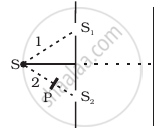Advertisements
Advertisements
प्रश्न
What is the angle of polarisation and obtain the equation for an angle of polarisation?
उत्तर
-
The angle of incidence at which the reflected beam is plane polarised light is called polarising angle (ip)

Polarisation by reflection - When ordinary light is incident on the surface of a transparent medium, the reflected light is partially plane polarised.
- The extent of polarization depends on the angle of incidence.
- For a particular angle of incidence, the reflected light is found to be plane polarised.
- The angle of incidence at which a beam of unpolarised light falling on a transparent surface is reflected as a beam of plane polarised light is called polarising angle or Brewster’s angle. It is denoted by i
- At polarising angle, the reflected transmitted rays are perpendicular to other.
ip + 90° + rp = 180°
rp = 90° – ip
From Snell’s law
`(sin "i"_"p")/(sin "r"_"p")` = n - Where n is the refractive index of the medium with respect to air.
- Substitute the value of r from Equation, we get,
`(sin"I"_"p")/(sin (90^circ - "i"_"p")) = (sin "i"_"p")/(sin "r"_"p")` = n
tan ip = n
This relation is known as Brewster’s law.
APPEARS IN
संबंधित प्रश्न
What is a Polaroid?
Draw a neat labelled diagram showing the plane of vibration and plane of polarisation for polarised light.
What dose a polaroid consist of?
Two polaroids P1 and P2 are placed with their pass axes perpendicular to each other. An unpolarised light of intensity Io is incident on P1. A third polaroid P3 is kept in between P1 and P2 such that its pass axis makes an angle of 45° with that of P1. Determine the intensity of light transmitted through P1, P2 and P3
The refractive indices of glass and water w.r.t. air are 3/2 and 4/3 respectively. Determine the refractive index of glass w.r.t. water.
Unpolarised light is passed through a polaroid P1. When this polarised beam passes through another polaroid P2 and if the pass axis of P2 makes angle θ with the pass axis of P1, then write the expression for the polarised beam passing through P2. Draw a plot showing the variation of intensity when θ varies from 0 to 2π.
The glass plate of refractive index 1.732 is to be used as a polarizer, its polarising angle is _______.
With the help of an experiment, state how will you identify whether a given beam of light is polarised or unpolarized?
State any two methods by which ordinary light can be polarised
Unpolarised light is incident on a polaroid. How would the intensity of transmitted light change when the polaroid is rotated?
A ray of light is incident on a transparent medium at a polarizing angle. What is the angle between the reflected ray and the refracted ray?
Discuss polarisation by selective absorption.
List the uses of polaroids.
Discuss about pile of plates.
Mention the types of optically active crystals with example.
For the same objective, find the ratio of the least separation between two points to be distinguished by a microscope for light of 5000 Å and electrons accelerated through 100 V used as the illuminating substance.
Figure shown a two slit arrangement with a source which emits unpolarised light. P is a polariser with axis whose direction is not given. If I0 is the intensity of the principal maxima when no polariser is present, calculate in the present case, the intensity of the principal maxima as well as of the first minima.

A polarizer - analyser set is adjusted such that the intensity of light coming out of the analyser is just 10% of the original intensity. Assuming that the polarizer - analyser set does not absorb any light, the angle by which the analyser need to be rotated further to reduce the output intensity to be zero, is ______.
